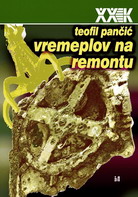 Pančić, Teofil – Overhauling the Time Machine. Life and Death in Serbian Post-communism
Pančić, Teofil – Overhauling the Time Machine. Life and Death in Serbian Post-communism
2010, pp. 384
Price $10
Cover Design: Ivan Mesner
Teofil Pančić was born in Skopje in 1965. He writes columns, essays, commentaries, and literary reviews for the weekly magazine Vreme, as well as for other media in Serbia and surrounding areas. Before publishing the present work, The 20th Century Library had published the first three volumes of his series of books with the common title Life and Death in Serbian Post-communism (Život i smrt u srpskom postkomunizmu): The Urban Bushmen (Urbani bušmani, 2001), The Keepers of Bengal Fireworks (Čuvari bengalske vatre, 2004), Navigating Through Canyons (Kroz klisurine, 2007), as well a volume of his columns, entitled Karma Coma (Karma koma, 2007). The texts in the present volume cover the period from 2006 to 2009.
FOREWARD
The book Overhauling the Time Machine is the fourth installment of the series Life and Death in Serbian Post-communism, and making any sense while writing this peculiar preface to his own book is an unprecedented challenge to this author. Why is it so? Serbija hasn’t yet completed the historical phase, called (among other things) post-communism, nor has it renounced using „life and death“ issues as political or any other kind of tools. However, it seems that the period in which these texts were produced, spanning between March of 2006 (the death of Slobodan Miloševic) and the end of 2009, is virtually impossible to designate or name, by a single word, unless it is the word confusion.
On the one hand, it is as if the years following the physical death of the principal creator of Serbia of the 90s were less the time of irrevocable backing away from his legacy, and more the time of last-ditch efforts to find at any cost – even at the cost of serial raping of people’s intelligence and memory – in his political and world-view legacy some “healthy core“, worth saving and replicating, even if had to be slightly repackaged. This is a peculiar restoration aspect of this period, particularly salient during its first half. On the other hand, there came a moment in which Serbia was placed before a choice- in part because of the dynamics of its own political and social processes, and in part because that choice was imposed from outside – between old and tried harmful paradigms and something the future had in store for it. And Ser-
bia, perhaps not very convincingly, but still with an electoral majority, chose the future? Is it a happy ending? Not really: those who liked to pass themselves for its representatives were not able, did not wish, or were not allowed to reject more decisively public mantras of previous politics, even if that meant leaving Serbia stuck in limbo. Naturally, the most frequent catalyst for all these, primarily value-related dilemmas and uncertainties that were not without practical consequences, is the famous „Kosovo issue“, which precisely during this period began to move toward resolution (although not by the will of any of the local political protagonists). It is the reason why so much space in this book is devoted to the period in question. One easily recognizable, decades-old, pattern emerges here: whenever there is talk of “Kosovo“ as a “to be or not to be“ or faith versus faithlessness issue, or something of that sort, it really is always about anything else but Kosovo. The true topic is Serbia itself, specifically, by whom and how will its dominant social values be defined. One thing is beyond any doubt: The above described “time machine “ strategy has suffered a historic defeat. That is why the “time machine“ is undergoing an overhaul, but complacency is uncalled for, for is not clear at all whether the mechanics know what they are doing.
T. P.
